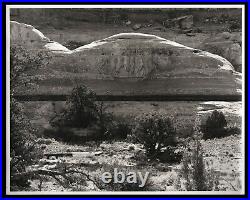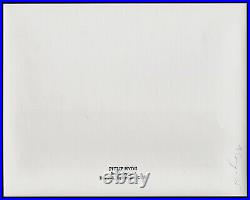


California Landscape – Rock detail, abstract. Original vintage silver gelatin photograph – scarce. Photographer’s ink stamps and notations on verso. Date Of Print: 1955 – 1962. Double weight fiber based photographic paper. 8 x 10 inches. Many people refer to Philip Hyde as the underappreciated master landscape photographer of the 20th Century. His photographs participated in more environmental campaigns than those of any other photographer. At the birth of the modern environmental movement, he was one of the primary illustrators of the groundbreaking Sierra Club Exhibit Format Series. He dedicated his life to defending Western American wilderness, working with the Wilderness Society, National Audubon and others. His color landscapes inspired a generation of photographers, while helping to establish color photography as a fine art. His photographs helped protect Dinosaur National Monument, the Grand Canyon, the Coast Redwoods, Point Reyes, King’s Canyon, Canyon de Chelly, the North Cascades, Canyonlands, the Wind Rivers, Big Sur and many other National Parks and wilderness areas. American Photo Magazine named Philip Hyde’s photograph, “Cathedral In The Desert, Glen Canyon, Utah, 1964″ one of the top 100 photographs of the 20th century. Ansel Adams said that Philip Hyde was one of the very best photographers of the natural scene in America. ” Pulitzer Prize winning photographer Jack Dykinga said, “Philip Hyde inspired many of the’Who’s Who’ of Landscape Photography working today. ” In Outdoor Photographer and many other magazines, Philip Hyde is referred to as “one of the all-time most influential landscape masters. Born and raised in San Francisco, Philip Hyde lived for 50 years in the house he built in the Sierra Nevada Mountains of California with his late wife Ardis. At the California School of Fine Arts, now the San Francisco Art Institute, Philip Hyde studied under Ansel Adams, Minor White, Edward Weston, Imogen Cunningham, Lisette Model, Dorothea Lange and other definers of the medium. Philip Hyde’s work has appeared in more than 80 books and 100 major publications including The New York Times, Audubon, Life, National Geographic, Aperture, B&W Magazine, Fortune and Newsweek. His work has been exhibited in over 100 of North America’s finest venues. Please see lists of exhibitions under “INFO”. The North American Nature Photography Association honored him with a lifetime achievement award in 1996. He received the California Conservation Council’s Merit Award in 1962 and the Albert Bender Grant in 1956. In 2009, the International League of Conservation Photographers made Philip Hyde an honorary member. In most cases Hyde made only 2 or 4 prints of a given image and on rare occasions would print 8 prints from a specific negative but, never more. These extremely low print numbers (Ansel Adams routinely printed hundreds of prints from a negative) have resulted in Hyde’s vintage silver gelatin prints being extremely rare and mostly unavailable (long ago snapped up by savvy collectors). A small number of Hyde’s vintage silver gelatin prints were offered by a handful of prestigious photography galleries Weston Gallery, Scott Nichols Gallery, etc. Philip Hyde original vintage prints are extremely RARE. Philip Hyde never printed more than eight prints of a given image and in most cases he printed only two to four. Variations in value are due to several factors, but are primarily based on the photograph’s subsequent significance, exhibition history, publishing history, etc. There is generally little variation in condition, with a few exceptions.

